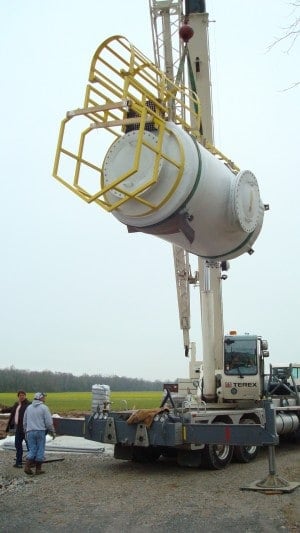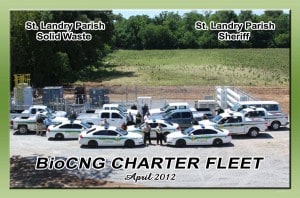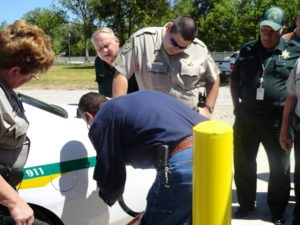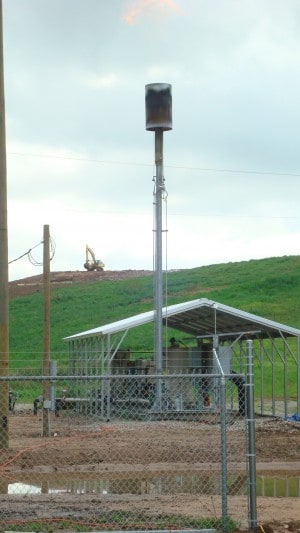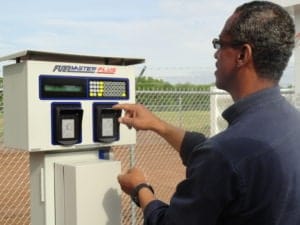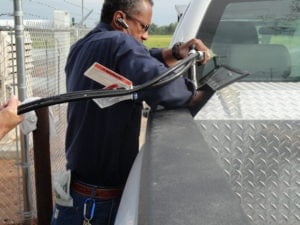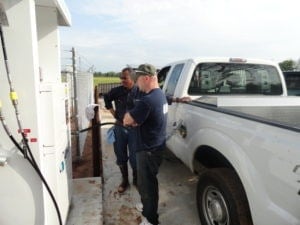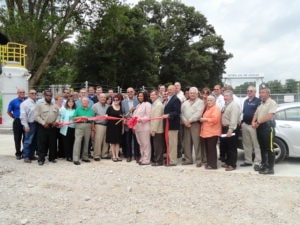In the Spotlight
St. Landry Parish Solid Waste Disposal District: Turning Landfill Gas Into Biofuel
On of the pioneers in biogas use, St. Landry Parish Solid Waste Disposal District has used its landfill gas to fuel vehicles in their local Sheriff’s Department.
Born out of the need to deal with open dumps in the late 1970s, the St Landry Parish Solid Waste Disposal District was created, its purpose, to deal with the growing problem. Before its creation, waste was collected by a multitude of local haulers, who took the waste to one of many open dumpsites. Then, in 1980, the St. Landry Parish Government, formerly the St. Landry Parish Police Jury, along with the Parish’s 12 municipalities, petitioned the Louisiana legislature to create the St. Landry Parish Solid Waste Disposal District in accordance with 1979 state law which required the clean up of all open dumps by January, 1986. The District continues to be governed by a board of commissioners, appointed by local elected officials meeting monthly to address ongoing solid waste problems (see Commissioners sidebar).
Now serving a population of 110,000 residing in St. Landry and Evangeline Parishes (South Central Louisiana), the Solid Waste Disposal District specializes in comprehensive disposal and waste diversion practices, including traditional recycling initiatives. The District employs 28 full-time staffers engaged in landfill operations, recycling collection and processing, general administration and public education.
Strong and Steady
During this turbulent economy, the St. Landry Parish Solid Waste District was not adversely affected, although Katry Martin, the District’s Executive Director, does point out that there has been slightly less waste generated due to the slow down in construction activity over the last three to five years. The District’s waste acceptance rate has really not varied significantly either way. “Local Sales Taxes fund the bulk of operations in our Parish. Those sales taxes have not varied significantly,” says Martin. “In fact, they have actually rebounded since 2008, so we haven’t had any real deviation in our revenue source that we use to deliver programs and services.”
What Martin finds is that most of the District’s attention is directed specifically to regulatory issues, recently dealing with greenhouse gases and greenhouse gas reporting—requirements that have been imposed by the EPA. “We find that our biggest challenge is keeping up with regulatory matters that are constantly changing and the costs associated with that.” Very active on the regulatory front, the District keeps informed of all the changes in state and federal laws by attending most of the industry conferences that are available. In addition, employees are trained, licensed and certified in operating and maintaining landfills, and they also keep the District up to date on any changes or updates to the regulatory code. Martin says, “At every turn, we attempt to find some way to monetize environmental attributes available through certain practices. For example, we monetize carbon credits created from voluntary greenhouse gas reductions,” says Martin. “The destruction of potent gases in advance of regulatory requirements will allow the District to market the offsets developing a revenue stream to aid in saving on capital costs directly related to regulatory compliance.” Martin also points out that finding a valuable use for landfill gas will also develop a revenue source that will continue to aid in offsetting costs. The District invests in technologies that provide less costly ways to comply with strict regulations. In addition savings are derived by performing environmental tasks in house such as waste water sampling and analysis.
Interweaving Training and Safety
Not only does the St. Landry Parish Solid Waste Disposal District outsource professional training, but they also invite professionals from the field in-house on a quarterly basis to go over training material on disposal and waste reduction practices. The District is also an affiliate of the State and national associations that provide additional training resources, including the Louisiana Solid Waste Association and SWANA. Martin points out that their operators are certified through the State solid waste association at different levels depending on work requirements and classes and they have supervisors that provide professional training in the areas for which they are responsible. “All of the employees have the opportunity to attend classes and approximately half are required to be certified, also a part of the job requirement; the other half do so on a voluntary basis, so we support these efforts. They voluntarily train because it is reflected in their pay grade,” says Martin.
At the same time, operational training is interfaced with the District’s safety programs. Martin states that the conferences and internal training both provide knowledge on the field of expertise as well as the safety associated with all of these activities. Therefore, safety is incorporated with their training and both have been done on a monthly and quarterly basis.
Community Involvement
With a very aggressive outreach and educational program for both school students and adults, St. Landry Parish Solid Waste Disposal District provides professional educational material for elementary schools in the Parish. The teaching material is tailored so it coincides with treading math and science skills. For example, it may involve calculating the value of recycled material or discuss citizenship and stewardship as it relates to litter campaigning, etc. Since this educational material meets the State educational requirements for lesson planning, it is incorporated into all of the elementary schools via the school board and the local principals. “We have found this material tremendously successful and have had high levels of educators who use this teaching material, quantify and recognize high levels of recycling participation,” says Martin. Monitoring the recycling of all 50 institutions they partner with, the District also provides teaching material through an annual calendar on environmental and waste management practices in the Parish that is delivered to students and faculty members.
The District also hosts more than 1,000 students, teachers and parents each year at their facilities and coordinates with fairs and festivals as well to provide recycling containers and booth space in order to provide information about their waste management practices. Martin says they also have a number of gardening clubs, plant and home festivals that they attend where they are well received by the community. “Those who are knowledgeable about the solid waste program are always fascinated about what is happening in our organization. Being a public jurisdiction we are we certainly are answerable to the general public,” says Martin.
The Biogas Project
St. Landry Solid Waste District operates a type II municipal solid waste landfill, which was permitted to begin operations in 1986. Receiving approximately 400 tons of waste each day, six days per week for nearly 30 years, the total waste in place equals to 2.75 million tons. Back in late 2008, the District saw fit to invest $750,000 in a landfill gas collection system with the intent of marketing the carbon reductions and using the proceeds to pay for the cost of the system. Since then, the commission has developed gross sales of $750,000. Martin points out, “What is unique about St. Landry Parish all of the investments in the gas system were funded by the District, not by any project developer from the outside. In addition, it has continued operation debt-free and all maintenance is done in-house.” Now, not only does the district own and operate a successful gas collection system, it has also opened up the opportunity to find a beneficial use for the gas, specifically the recently completed biogas project.
In 2011 the choice was made to develop a vehicle fuel project based on a complete evaluation of all the potential uses for landfill gas in the District’s region. “Nothing that was considered outside of vehicle fuel project was deemed to be economical. We could not recover enough on the sale of generated power to offset the investment costs. It was possible, but it wasn’t feasible. It also wasn’t practical to convey the landfill gas 12 miles to the next buyer for gas or heat, particularly since natural gas prices are cheap in Louisiana. We were being opportunistic by looking to clean the gas and compress it in such a manner that it would be delivered as CNG or BioCNG for vehicle fuel,” says Martin.
At the time, only one other system had been installed at a U.S. landfill (Madison, WI) and on an animal waste digestor in Janesville, WI,both small scale. Points out Martin, “Collecting, cleaning and using landfill gas is not new, but using the landfill gas as a biogas to fuel vehicles is new. The use of CNG in general is growing in popularity, particularly in regions where natural gas is cheap. There is a lot of interest in subsidies made available for municipal jurisdictions to fuel their trucks and refuse vehicles with natural gas. In those facilities they bring in the natural gas through a pipeline whereas in our facilities, we created our own natural gas from landfill gas.”
The District invested $850,000 in capital with assistance from federal and State sources to installed a conditioning system, compression unit and a CNG fueling dispenser. The cost to convert 15 fleet vehicles amounted to approximately $200,000, just over 10,000 per vehicle, and the remaining costs went to the purchase and the installation of the dispensing system. Martin stresses that the District could have chosen to use their resources to fully fund the project but they felt it would be more practical to use the subsidies available to them to offset the capital cost. “It was our responsibility to acquire some subsidies in order to aid in the cost of the capital. Funding was available, it was just important that we leveraged a portion against State and federal sources,” says Martin.
The District ended up drawing from the talents of individuals who have provided services to the district over the years. For example, they called upon the consultants who do the District’s air quality work. They also drew from the carbon developer that handles their carbon offsets and carbon marketing to aid the District in the review process. In addition, they located a company who would develop the technology to deliver and dispense the biogas and required that their engineer who designed (and continues to maintain) the disposal site be a project coordinator in order to make sure they met all of our State bid requirements. Finally, they relied upon the Department of Natural Resources to administer some funding made available through the Department of Energy. And they were fortunate enough to have a local company who was just beginning to provide conversion service and the technology to covert the vehicles. “Most importantly, our Commissioners as well as our technicians served as project managers,” says Martin. “We did the entire site work ourselves and we managed the gas collection. From my perspective, I think this as a unique as you’ll find. We have had to pioneer through most of this. We’re not experts but we do know who to call and how to educate ourselves. However, we find that we don’t have a lot of latitude when it comes to success and failure. If we are not the 24/7 service company for our own system, we have to rely on those outside who may not have as much vested interest or who may not deliver—then the project may not be as successful.” Martin says that they also make sure to carefully watch the treatment and conditioning of the landfill gas. Biogas is a dirty gas and the greatest cost is in maintaining the filter component, they are working through different types of filter media and its life expectancies.
As far as choosing the first vehicles to be converted, the District was excited that the local Sheriff’s department was willing to provide a significant part of their fleet for the project. Since the Sheriff’s Department has the largest single fleet in St. Landry Parish, the District thought it would be very advantageous to fuel their vehicles with CNG, especially since gas rates were approaching $4.00 per gallon. Says Martin, “The Sheriff’s fleet consumes a large amount of fuel. We negotiated with the Sheriff and agreed upon a flat rate per gallon while providing the cost of vehicle conversions. He just needed to provide the fleet and sign a purchase agreement.” In addition, some of their small service vehicles used for maintaining the landfill was converted as well. So far, says Martin, everyone is very happy with the results. “This project was well-conceived and we think we kept everything within manageable size and scope. The Commission agreed to accept the funding in July 2011 and we were fueling vehicles in March 2012. From July 2011, the District went through the planning process, operations, acquisition of the equipment, installations, training, etc. We now like to say that we were successful in the ongoing treatment and delivery of compressed biogas and we are determined to continue to make this thing work. If it continues to be successful, we will consider some modest expansions.” Opportunities for further development are in conceptual stages right now, including expanding the use of the available landfill gas. Even though the District has fuel for 500 vehicles, they are only using it for 15, so they have plenty of capacity to expand. However, Martin points out that the new technology is expensive. “We have to continue to find some subsidies or other funding where we can get a return on the capital that is suitable for public investment.”
Continuing Pioneers
Without question, the St. Landry Parish Solid Waste Disposal District’s biggest success in the last few years has been the biogas project. Although, Martin points out that there have been other things they have done that they are proud of, including being the first to line the landfill in advance of new regulations. And, in the last two decades they worked on the forefront regarding waste reduction practices and recycling. Most Parishes have some recycling programs but St, Landry not only has a routing and collection system, but it also provides the processing and marketing. “Determining where we might go from here is our biggest challenge right now. We will continue to develop vehicle fuel even further and we may have an opportunity to develop a high BTU project and inject biogas into a natural gas pipeline. Beyond that we will continue to keep our ears open and our eyes open at the new technology conferences as it relates to further reducing waste, waste management and landfill gas management. We are contemplating curbside service to our constituents but we want to do so in a select manner. We don’t want to just open that door to the high cost of transportation that will compromise our recycling initiative. These are a few items that we will continue to develop further.”
For now, St. Landry Parish Solid Waste Disposal District continues to be very proud to have been pioneers in the biogas area. Says Martin, “It is usually common for large facilities to excel in these areas. You find things like this happening in places that can host outside investors and developers or have large amounts of waste and landfill gas. There is less margin for error. We think our success is resounded in the fact that we’ve done so on a smaller than average site, most uncommon.”
For more information on the St. Landry Parish Solid Waste Disposal District, contact Katry Martin at (337) 826-5211, via e-mail at[email protected] or visit www.slpsolidwaste.org.
District takes delivery of the sulfur treatment vessel, a part of the biogas conditioning system.
The charter fleet commissioned to use biogas from the landfill gas generated at the St. Landry Parish Landfill in Beggs, LA. The St. Landry Parish Sheriff partnered with the St. Landry Parish Solid Waste District on the project.
Fueling demonstration for St. Landry Parish Sheriff deputies.
St. Landry Parish Landfill utility flare, an integral part of the biogas collection and control system.
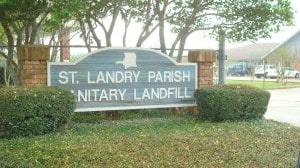
Entrance to the St. Landry Parish Landfill in Begs, LA.
St. Landry Parish Solid Waste Technician, Faltry Jolivette, initializes the new BioCNG dispensing system at the Parish Landfill in Beggs, LA
Photos courtesy of St. Landry Parish Solid Waste Disposal District.
St. Landry Parish Director of Tourism, Celeste Gomez, and State Representative, Ledrika Theirry are pictured at the commissioning of Louisiana’s first BioCNG fueling station located at the St. Landry Parish Landfill.
A group of dignitaries were on hand for the ribbon cutting ceremonies at the St. Landry parish Landfill to celebrate the opening of the Biogas to CNG fueling station.
Photos courtesy of the St. Landry Parish Chamber of Commerce.
Sidebar
Commissioners
Nine Commissioners are appointed to oversee the St. Landry Parish Solid Waste Disposal District. The commissioners are appointed as follows:
Four commissioners are appointed by St. Landry Parish Government
Four commissioners are appointed by the various municipalities
One commissioner is appointed by the St. Landry Parish Municipal Association
The commissioners serve staggered four-year terms. The Commissioners hire an Executive Director (Katry Martin) to oversee the operations of the District. As of March 2010 the Commissioners are:
Kathy Moreau
Jerry Domengeaux
D.L. Vidrine
Eddie Godwin
Gardie McManus
Cyrus Auzenne
Edward Briscoe
A.F. Pete Oliver
Jodie Powell

